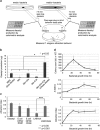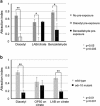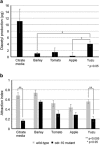A natural odor attraction between lactic acid bacteria and the nematode Caenorhabditis elegans
- PMID: 26241504
- PMCID: PMC4817685
- DOI: 10.1038/ismej.2015.134
A natural odor attraction between lactic acid bacteria and the nematode Caenorhabditis elegans
Abstract
Animal predators can track prey using their keen sense of smell. The bacteriovorous nematode Caenorhabditis elegans employs sensitive olfactory sensory neurons that express vertebrate-like odor receptors to locate bacteria. C. elegans displays odor-related behaviors such as attraction, aversion and adaptation, but the ecological significance of these behaviors is not known. Using a combination of food microbiology and genetics, we elucidate a possible predator-prey relationship between C. elegans and lactic acid bacteria (LAB) in rotting citrus fruit. LAB produces the volatile odor diacetyl as an oxidized by-product of fermentation in the presence of citrate. We show that C. elegans is attracted to LAB when grown on citrate media or Citrus medica L, commonly known as yuzu, a citrus fruit native to East Asia, and this attraction is mediated by the diacetyl odor receptor, ODR-10. We isolated a wild LAB strain and a wild C. elegans-related nematode from rotten yuzu, and demonstrate that the wild nematode was attracted to the diacetyl produced by LAB. These results not only identify an ecological function for a C. elegans olfactory behavior, but contribute to the growing understanding of ecological relationships between the microbial and metazoan worlds.
Figures




Similar articles
-
Screening of odor-receptor pairs in Caenorhabditis elegans reveals different receptors for high and low odor concentrations.Sci Signal. 2014 Apr 29;7(323):ra39. doi: 10.1126/scisignal.2005136. Sci Signal. 2014. PMID: 24782565
-
Reprogramming chemotaxis responses: sensory neurons define olfactory preferences in C. elegans.Cell. 1997 Oct 17;91(2):161-9. doi: 10.1016/s0092-8674(00)80399-2. Cell. 1997. PMID: 9346234
-
A Circuit for Gradient Climbing in C. elegans Chemotaxis.Cell Rep. 2015 Sep 22;12(11):1748-60. doi: 10.1016/j.celrep.2015.08.032. Epub 2015 Sep 10. Cell Rep. 2015. PMID: 26365196 Free PMC article.
-
Genetics of chemotaxis and thermotaxis in the nematode Caenorhabditis elegans.Annu Rev Genet. 1999;33:399-422. doi: 10.1146/annurev.genet.33.1.399. Annu Rev Genet. 1999. PMID: 10690413 Review.
-
Molecular neurogenetics of chemotaxis and thermotaxis in the nematode Caenorhabditis elegans.Bioessays. 1997 Dec;19(12):1055-64. doi: 10.1002/bies.950191204. Bioessays. 1997. PMID: 9454556 Review.
Cited by
-
Diacetyl odor shortens longevity conferred by food deprivation in C. elegans via downregulation of DAF-16/FOXO.Aging Cell. 2021 Jan;20(1):e13300. doi: 10.1111/acel.13300. Epub 2020 Dec 31. Aging Cell. 2021. PMID: 33382195 Free PMC article.
-
Identification of attractive odorants released by preferred bacterial food found in the natural habitats of C. elegans.PLoS One. 2018 Jul 23;13(7):e0201158. doi: 10.1371/journal.pone.0201158. eCollection 2018. PLoS One. 2018. PMID: 30036396 Free PMC article.
-
An automatic measurement method for the response of Caenorhabditis elegans to chemicals.Technol Health Care. 2024;32(S1):145-154. doi: 10.3233/THC-248013. Technol Health Care. 2024. PMID: 38759045 Free PMC article.
-
Transgenerational effects of alcohol on behavioral sensitivity to alcohol in Caenorhabditis elegans.PLoS One. 2022 Oct 18;17(10):e0271849. doi: 10.1371/journal.pone.0271849. eCollection 2022. PLoS One. 2022. PMID: 36256641 Free PMC article.
-
Bacterial Metabolites Produced Under Iron Limitation Kill Pinewood Nematode and Attract Caenorhabditis elegans.Front Microbiol. 2019 Sep 19;10:2166. doi: 10.3389/fmicb.2019.02166. eCollection 2019. Front Microbiol. 2019. PMID: 31608025 Free PMC article.
References
-
- Aunsbjerg SD, Honore AH, Marcussen J, Ebrahimi P, Vogensen FK, Benfeldt C et al. (2015). Contribution of volatiles to the antifungal effect of Lactobacillus paracasei in defined medium and yogurt. Int J Food Microbiol 194: 46–53. - PubMed
-
- Bargmann CI, Horvitz HR. (1991). Chemosensory neurons with overlapping functions direct chemotaxis to multiple chemicals in C. elegans. Neuron 7: 729–742. - PubMed
-
- Bargmann CI, Hartwieg E, Horvitz HR. (1993). Odorant-selective genes and neurons mediate olfaction in C. elegans. Cell 74: 515–527. - PubMed
-
- Barriere A, Felix MA. (2005). High local genetic diversity and low outcrossing rate in Caenorhabditis elegans natural populations. Curr Biol 15: 1176–1184. - PubMed
-
- Barriere A, Felix MA. (2014). Isolation of C. elegans and related nematodes. WormBook e-pub ahead of print 2 May 2014; doi:10.1895/wormbook.1.115.2. - PubMed
Publication types
MeSH terms
Substances
LinkOut - more resources
Full Text Sources
Other Literature Sources
Miscellaneous

